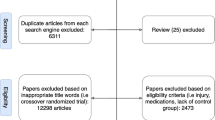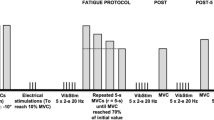Abstract
In comparison to the H-reflex, the task dependency of the human stretch reflex during locomotive and postural tasks has not received a great deal of attention in the literature. The few studies on reflex task dependency that have been performed to date have concentrated on either the group Ia mediated H-reflex or the short latency stretch reflex. In the present study the medium latency component of a mechanically evoked stretch reflex is investigated during walking, pedalling, and sitting. Stretch reflexes were evoked in the soleus muscle using dorsiflexion perturbations generated with a portable stretching device. Perturbations of equal amplitude and velocity (8 deg, 300 deg/s) were presented to 16 healthy subjects while they walked on a treadmill and pedalled a cycle ergometer. For eight of these subjects, an additional set of data was collected as they sat on the ergometer holding a steady posture. Perturbations were presented in the early to mid stance phase of walking and the downstroke of the pedal cycle. During all three conditions, the background soleus muscle activity was matched. The short (SLR) and medium (MLR) components of the soleus reflex responses were quantified by calculating the area of each burst in a 15-ms window centred on the peak of the respective burst. In addition, the stretch velocity-stretch reflex input-output curve was examined for the two locomotion tasks over a range of velocities from 100 to 400 deg/s. Peak latencies for the two reflex responses were observed at 52±5/77±6 ms (SLR/MLR) for walking, 51±3/76±6 ms (SLR/MLR) for pedalling, and 50±3/76±7 ms for sitting. A statistically significant increase in the magnitude of the MLR was observed during walking compared with pedalling and sitting (P=0.007), whereas no difference in magnitude was observed between the three tasks for the SLR (P=0.616). Furthermore, no difference was observed in the stretch velocity-stretch reflex input-output relationship between walking and pedalling. It is suggested that the medium component of the stretch reflex response is modulated to provide increased control for the postural demands of walking.
Similar content being viewed by others
Author information
Authors and Affiliations
Corresponding author
Rights and permissions
About this article
Cite this article
Grey, M.J., Larsen, B. & Sinkjær, T. A task dependent change in the medium latency component of the soleus stretch reflex. Exp Brain Res 145, 316–322 (2002). https://doi.org/10.1007/s00221-002-1109-6
Received:
Accepted:
Published:
Issue Date:
DOI: https://doi.org/10.1007/s00221-002-1109-6




